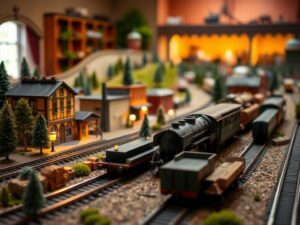How to Maintain Turnouts and Switches in Your HO Scale Layout
How to Maintain Turnouts and Switches in Your HO Scale Layout
How to Maintain Turnouts and Switches in Your HO Scale Layout
Welcome back to the blog, fellow train enthusiasts! Today, we’re diving into a topic crucial for every model railroader, regardless of experience level: maintaining your turnouts (or switches as some call them).
In the wonderful world of HO scale, where tiny locomotives haul miniature freight and passenger cars, ensuring those little metal arms flip correctly is paramount to smooth train operation.
Think about it â turnouts are like the crossroads on your railroad map, guiding trains from one track to another. A malfunctioning turnout can derail your progress, literally! But fear not, with a bit of TLC and some simple techniques, you can keep those switches working flawlessly, keeping your HO scale dream running on time.
Understanding HO Scale Turnouts
Before we delve into maintenance, let’s take a quick peek at how HO scale turnouts work. They typically consist of:
- Point Rails: These are the rails that connect to the main lines and the siding track. The movable section called “points” can switch traffic either straight ahead or onto the sidetrack.
- Guard Rails: Located along the sides, they keep the wheels of your trains on the correct track during normal operation. Theyâre especially important when trains are passing through the turnout at low speed or reversing direction.
- Switch Mechanism: This is what actually moves those point rails, allowing the train to take either path. Many turnouts use a lever or linkage system powered by your DCC controller, but some rely on magnets for control.
The Essentials: A Simple Maintenance Routine
Maintaining your HO scale turnouts doesn’t require a huge time investment, especially if you implement these simple practices:
1. Regular Cleaning: This is crucial! Dust, grime, and even microscopic debris can accumulate over time, interfering with smooth operation and leading to sluggish or jammed movements. Here’s what to use:
- A soft brush: Use a small brush specifically designed for electronics or miniature parts to gently sweep away loose debris from all the rails and moving parts.
- Alcohol wipes: Isopropyl alcohol can be helpful for cleaning stubborn grime and residues, just apply sparingly with a clean cloth. Avoid excessive amounts as it can damage certain plastic components.
- Lubrication (for mechanisms): Once cleaned, lightly lubricate moving parts with silicone oil or a specialized rail lubricant designed for model railroading. Too much lube can attract dirt and actually cause issues! A small drop is all you need on each pivot point and mechanism connection.
2. Visual Inspections: After every train session (or more often if you notice issues), give your turnouts a quick visual check:
* Alignment: Ensure the rails are properly aligned with no visible gaps or mismatches. You can sometimes see these by carefully shining a light down each track.
* Binding: Observe for any parts that appear to be sticking or binding during operation. Gently flex those areas and feel for any resistance.
* Secure connections: Make sure the wires and connections leading to your turnout mechanism are secure and in good condition, avoiding shorts or broken links.
Troubleshooting Common Turnout Problems
Here are some typical issues you might encounter and how to address them:
-
Switch won’t throw: Check the power supply, ensure the turnout lever or magnet is connected correctly, and inspect for any debris blocking movement. Also check your wiring! Loose connections can be surprisingly common.
-
Wheels jumping the rails: Make sure the points of your turnout are properly aligned and functioning correctly. Check if your trains’ flanges (the small edges on the wheels) are worn down.
-
Trains running over guardrails: This is a symptom of misaligned track or poorly set turnouts. Double-check alignment using level tools and make adjustments as needed.
Taking It Up A Notch: Advanced Tips
Now that you have a handle on the basics, let’s explore some more advanced techniques to elevate your HO scale turnout maintenance game:
1. Regular Cleaning with Compressed Air: For deeper cleaning, especially for dust buildup in hard-to-reach areas, use a can of compressed air specifically designed for electronics. Be careful not to use excessive force and hold the nozzle at a distance to avoid damage.
2. Replacing Worn Parts: Inspect your turnout mechanisms regularly for signs of wear and tear. Small plastic components, especially gears, may eventually require replacement to maintain smooth operation. You can often find these replacement parts online or through hobby stores.
3. Experiment with Different Lubricants: Silicon oil is a good all-purpose choice, but specialized rail lubricants are also available. These might be better suited for different track materials and environmental conditions (like colder temperatures).
- DCC Turnout Controls: If you’re using DCC (Digital Command Control), consider adding individual turnout controls for finer adjustment and smoother switching action.
The Power of Community
One of the most rewarding aspects of model railroading is the camaraderie! Donât hesitate to reach out to other hobbyists, both online and in local clubs, if you have any questions or need help troubleshooting specific issues with your HO scale turnouts. Sharing knowledge and tips helps everyone elevate their layouts to new levels!
Remember, by embracing a consistent maintenance routine and tackling challenges head-on, you’ll not only keep your trains running smoothly but also unlock the full potential of your HO scale world. Happy railroading!




